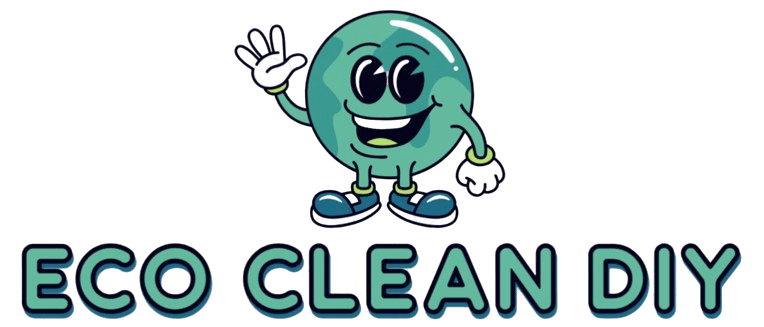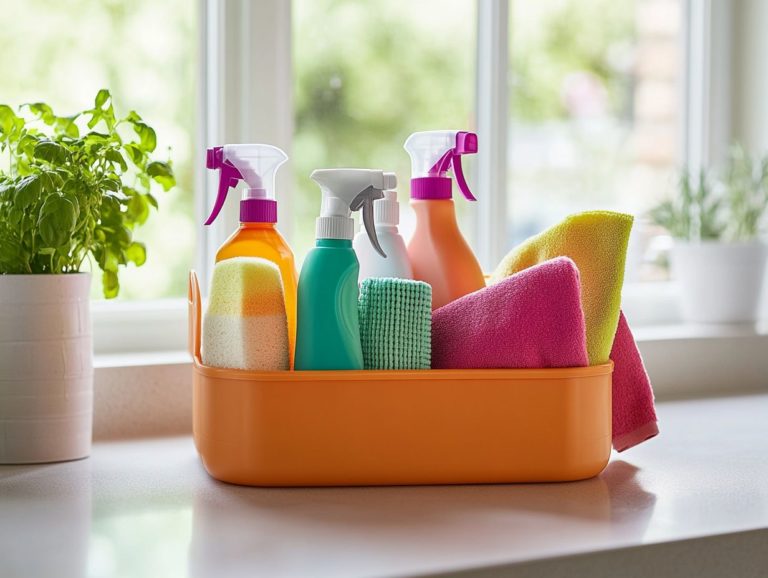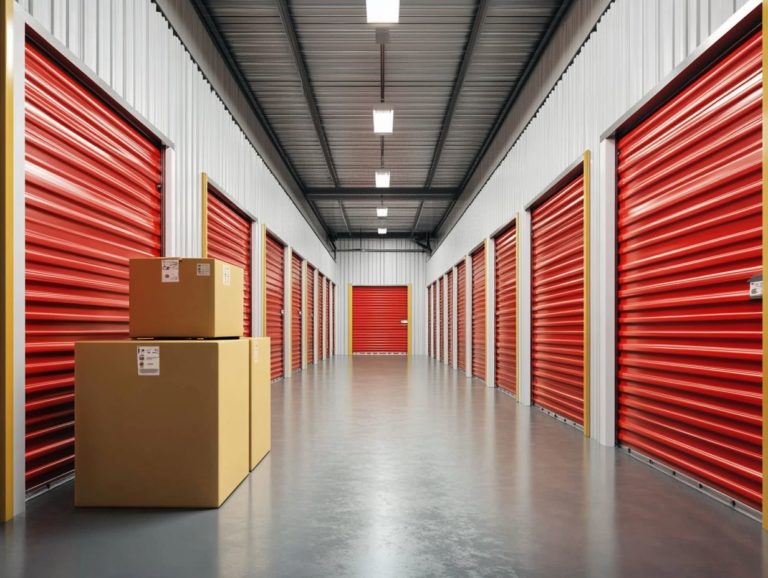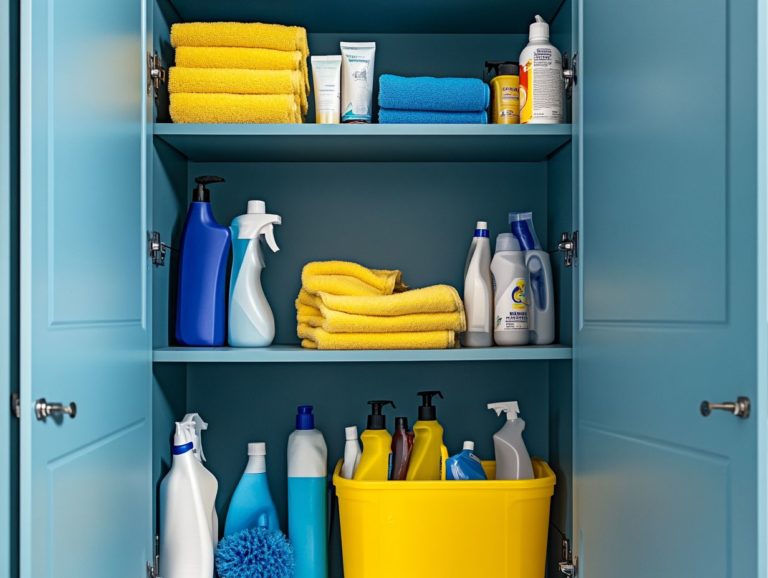How to Create a Cleaning Supply Inventory
Managing your cleaning supplies effectively is essential for fostering an efficient and organized environment, whether at home, in commercial cleaning, or in a professional setting.
A well-maintained cleaning supply inventory allows you to track your items seamlessly. This ensures you re never caught without essential products like disinfectant wipes and all-purpose cleaners.
Discover how a cleaning supply inventory can transform your space! This article also provides step-by-step guidance on creating and sustaining one with effective management practices.
It also highlights the benefits and best practices that will refine your cleaning processes, including efficient organization and quality control.
Continue reading to elevate your cleaning routine to new heights by leveraging advanced inventory management systems and digital tools!
Contents
- Key Takeaways:
- What Is a Cleaning Supply Inventory?
- Why Is a Cleaning Supply Inventory Important?
- How to Create a Cleaning Supply Inventory
- What Are the Benefits of Having a Cleaning Supply Inventory?
- What Are the Best Practices for Maintaining a Cleaning Supply Inventory?
- Frequently Asked Questions
- What is a cleaning supply inventory?
- Why is it important to create a cleaning supply inventory?
- How do I start creating a cleaning supply inventory?
- How often should I update my cleaning supply inventory?
- What information should I include in my cleaning supply inventory?
- Can I use a digital tool to create a cleaning supply inventory?
Key Takeaways:
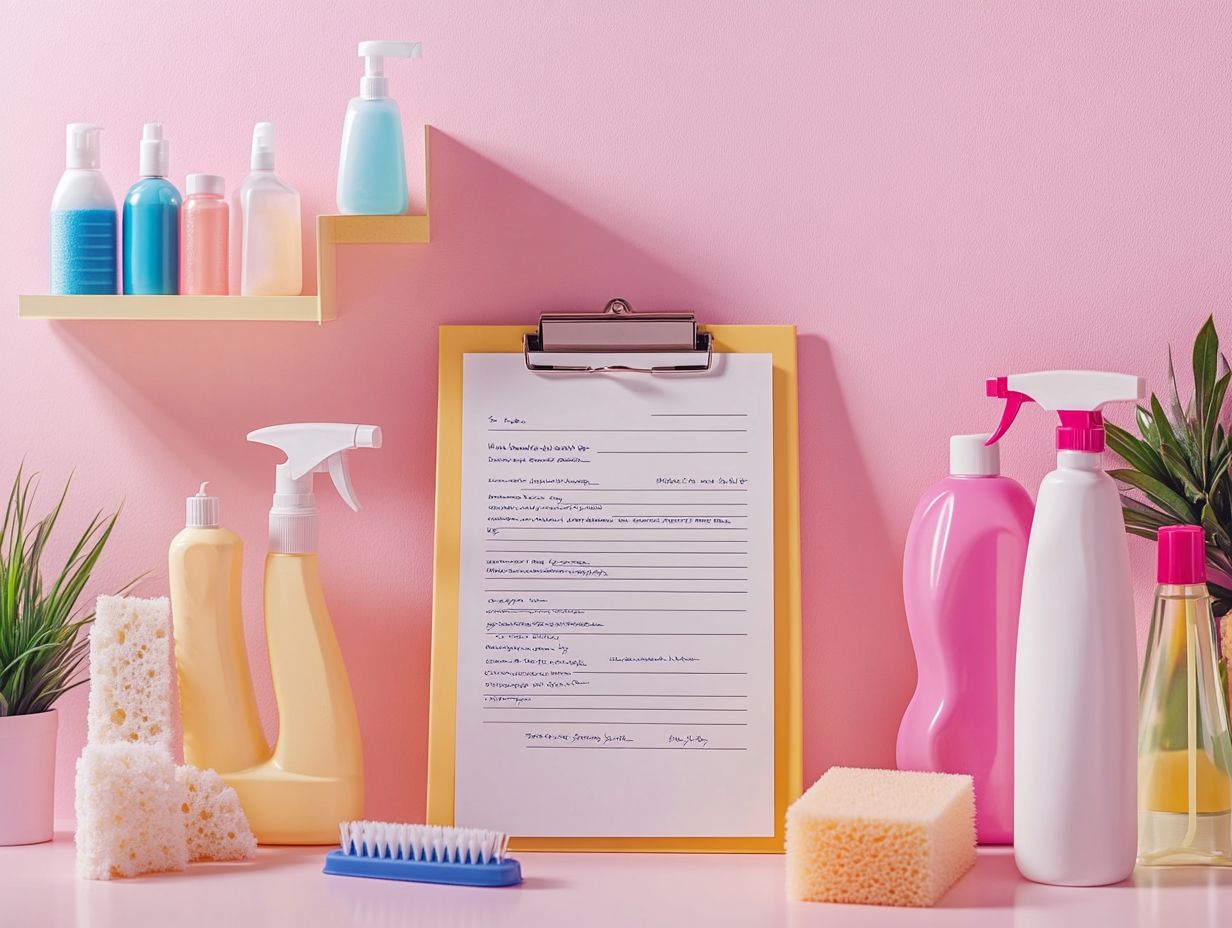
- Keep a dedicated storage area for cleaning supplies to maintain organization and efficiency.
- Regularly update the inventory to ensure adequate supply levels. This helps with budgeting, planning, and tracking expiration dates.
- Use the First In, First Out (FIFO) method and regularly check for expiration dates to save time and money while promoting proper cleaning supply management.
What Is a Cleaning Supply Inventory?
A cleaning supply inventory serves as a meticulous record of all cleaning supplies and equipment utilized across various settings, including commercial cleaning, residential cleaning, and facilities management. It includes a job-specific inventory for different cleaning environments.
This inventory encompasses essential items such as disinfectant wipes, all-purpose cleaners, microfiber cloths, paper towels, trash bags, and a range of cleaning chemicals. These items help maintain effective management and organization.
By utilizing user-friendly inventory management systems, you can streamline your processes, monitor inventory levels in real-time, and elevate your inventory management practices to a new level.
Why Is a Cleaning Supply Inventory Important?
A Cleaning Supply Inventory is crucial for significantly influencing the efficiency and effectiveness of your cleaning operations while affecting cost considerations and purchasing decisions.
By maintaining an organized inventory, you can easily track usage rates and manage inventory levels. This ensures that crucial supplies are always on hand, preventing costly interruptions during cleaning tasks.
How to Create a Cleaning Supply Inventory
Creating a cleaning supply inventory is a structured endeavor that allows cleaning professionals to manage supplies and equipment precisely. This ensures that nothing slips through the cracks.
Begin by crafting a comprehensive cleaning supply checklist; this will serve as your roadmap throughout the inventory process. Ensure essential items like disinfectant wipes, paper towels, rubber gloves, and various cleaning tools are accounted for.
Using digital tools, such as user-friendly inventory management systems, can significantly enhance your ability to track inventory and streamline your processes. This ensures seamless supply requests and stock management.
Start today and experience the difference in your cleaning efficiency!
1. Take Stock of Current Supplies
Taking stock of your current supplies is the essential first step in creating a cleaning supply inventory. This enables you to clearly understand the cleaning products at your disposal, including vital items like floor cleaner and trash bags.
Physically checking your storage areas allows you to accurately note existing cleaning supplies and assess their condition. This step is crucial for maintaining an efficient cleaning routine. Regular assessments help you identify usage rates, revealing how frequently products are utilized and highlighting items that may need to be reordered or replaced.
Documenting supplier information during this review ensures that your restocking processes run smoothly and on time. Establishing a comprehensive inventory system will streamline your operations and allow for proactive management of cleaning resources. This ultimately enhances the overall cleanliness of your workplace and ensures effective team management.
2. Categorize Cleaning Supplies
Categorizing your cleaning supplies is crucial for managing inventory efficiently. Organize items into logical groups such as:
- Cleaning chemicals
- Equipment
- Office supplies
- Eco-friendly products
By establishing distinct categories based on the type of cleaning task whether it s daily maintenance or deep cleaning you streamline your processes and significantly enhance productivity. Keeping daily maintenance products together ensures quick access for your staff, while more specialized deep cleaning supplies can be neatly tucked away, ready for when those intensive tasks arise. This method is a game changer for cleaning contractors!
Implementing tailored storage systems for each category optimizes usage, guaranteeing that all necessary supplies are easily located exactly when you need them. This ensures your cleaning environments are always well-prepared.
As supply trends evolve, staying informed about the latest cleaning innovations and maintaining up-to-date maintenance information is essential. This proactive approach helps your business adapt effectively to changes in the cleaning landscape.
3. Determine Reorder Levels
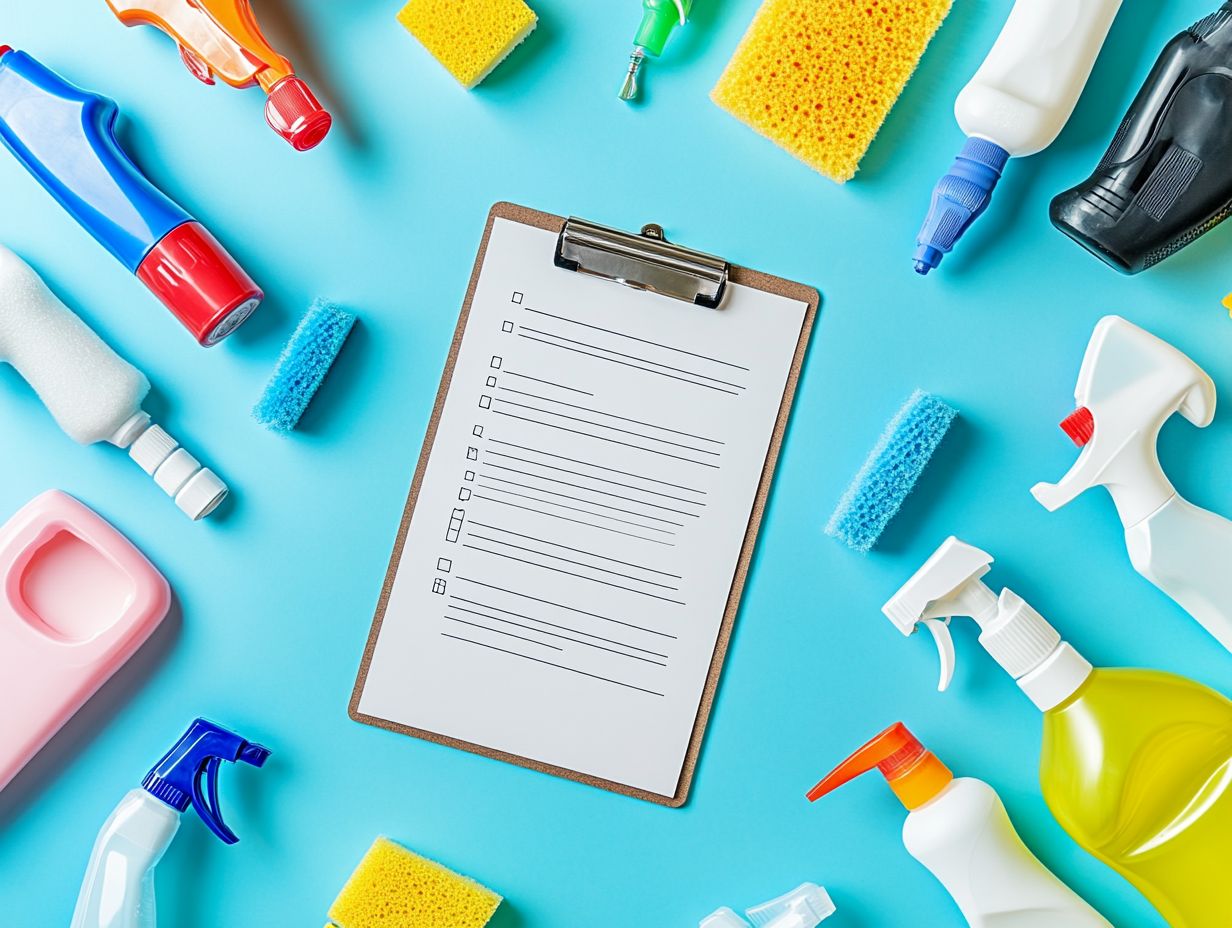
Determining reorder levels is vital for effectively managing your cleaning supply inventory. This ensures you always know when to restock items and maintain sufficient supply levels. Use an inventory checklist to ensure nothing is overlooked.
This process requires evaluating usage rates while also considering seasonal variations that may impact demand. During peak seasons, the need for specific cleaning supplies could surge, necessitating adjustments to your reorder points. By closely monitoring consumption patterns and trends, you can make informed purchasing decisions, ensuring the right supplies are available precisely when needed. An alert system can help automate this process.
An alert system can be particularly beneficial, notifying you when stock levels near the minimum threshold. Taking this proactive step ensures smooth operations and keeps your team on track, avoiding service disruptions and guaranteeing that your cleaning staff can carry out their responsibilities without delays.
4. Set Up a Tracking System
Establishing a robust tracking system for cleaning supplies is crucial for effective inventory management. This allows you to monitor stock levels and usage rates with precision. Utilize automated inventory methods and tracking technology.
Various approaches such as computer programs that keep track of stock automatically and specialized janitorial software help you maintain a comprehensive overview of your supplies. These advanced technologies offer real-time inventory updates, ensuring you always know what s in stock and what requires reordering. This is especially useful for managing supply requests effectively.
Integrating feedback mechanisms within these platforms allows your team to promptly report any discrepancies or shortages. Furthermore, cloud-based software significantly enhances this process, enabling seamless data access from anywhere at any time. This ultimately boosts your decision-making capabilities and operational efficiency, ensuring up-to-date maintenance and product information.
5. Regularly Update the Inventory
Regularly updating your cleaning supply inventory is essential for maintaining accurate records and ensuring that you remain fully aware of your stock levels.
This practice helps manage your supplies effectively and track expiration dates for cleaning chemicals. By instituting routine checks, you can avoid using outdated products that could compromise your sanitation efforts. Tools like janitorial software can automate these checks.
Utilizing historical data during these inspections allows for efficient organization, enabling your team to make smarter buying choices based on past usage. Ultimately, a well-maintained inventory system supports higher operational standards, ensuring cleanliness and safety are consistently upheld. Cleaning professionals will find this method a game-changer!
What Are the Benefits of Having a Cleaning Supply Inventory?
Maintaining a well-organized cleaning supply inventory offers a wealth of advantages. It saves you precious time and money by preventing over-purchasing and stockouts, while ensuring that essential supplies are always at the ready for your cleaning professionals.
This also facilitates better management of cleaning products and cleaning contractors.
1. Saves Time and Money
One of the key advantages of maintaining a cleaning supply inventory is that it enables you to save both time and money through efficient management and informed purchasing decisions, considering cost factors and supply trends.
By closely monitoring your inventory levels, you gain valuable insights into usage patterns and supply trends, significantly reducing waste and the risk of overstock situations.
When you have a firm grasp on your inventory needs, you can sidestep last-minute emergency purchases that often come with inflated prices. This proactive approach helps you stick to your budget and allows for more effective resource allocation, creating a more sustainable operational framework.
Leveraging tools like Coefficient.io, Excel, or Google Sheets can help streamline this process.
Keeping a well-organized supply inventory ensures that essential items are always at your fingertips, enhancing overall efficiency and cost-effectiveness. This is particularly important in the post-COVID-19 environment where cleanliness is paramount.
2. Ensures Adequate Supply Levels
Maintaining a well-organized cleaning supply inventory is essential for ensuring that you have adequate supply levels, preventing disruptions in your cleaning services, and maintaining operational efficiency.
Utilizing tools like janitorial software and inventory management systems can streamline your processes.
An organized inventory system actively supports you in planning your activities, allowing you to concentrate on your tasks instead of worrying about running out of essential items.
By tracking which supplies are running low, you can prioritize restocking them accordingly. Accurate maintenance information enables you to arrange timely replacements, minimizing the risk of dealing with unused or expired products.
Implementing real-time inventory tracking and an alert system can enhance your effective management.
This streamlined approach boosts your productivity and contributes to a cleaner and healthier environment for both your clients and your staff.
Choosing eco-friendly products isn t just smart it s essential for a healthier tomorrow!
3. Helps with Budgeting and Planning
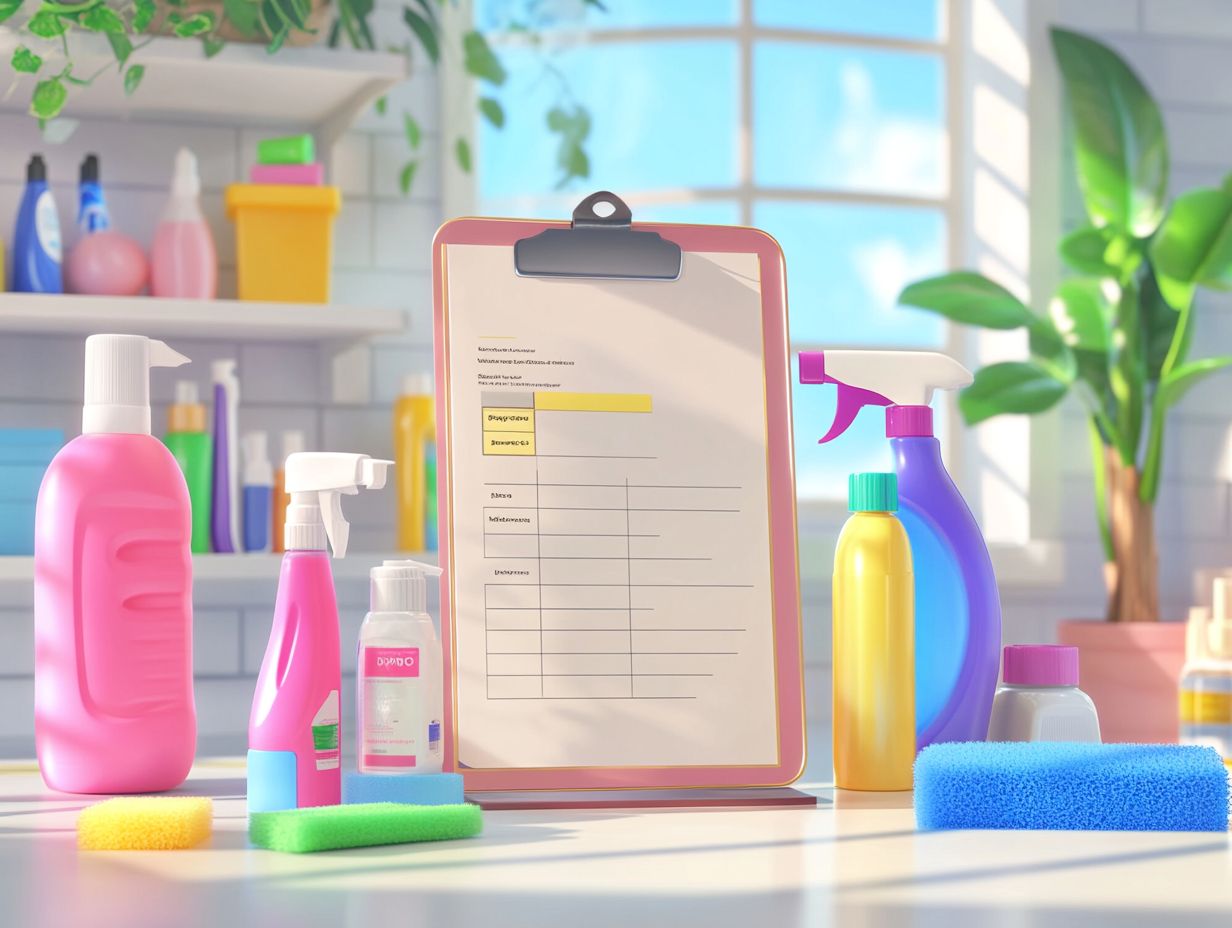
A cleaning supply inventory is crucial for budgeting and planning. It gives insights into your spending patterns and helps you predict future needs.
By analyzing this inventory data, you can uncover important supply patterns essential to your financial strategy. Historical data lets you identify trends, making it easier to anticipate future demands and allocate resources effectively.
With a clear understanding of when and how much cleaning supply you need, you can refine your purchasing processes. This reduces excess stock and minimizes waste. Smart decision-making can save you money and boost your efficiency, making a big difference in your operations!
Using cloud-based software streamlines your purchasing decisions.
4. Promotes Organization and Efficiency
Maintaining a well-organized cleaning supply inventory promotes efficiency and order. This allows your teams to operate seamlessly with clear communication.
When cleaning contractors implement a structured inventory system, all essential supplies are readily available. This enhances team collaboration by reducing miscommunication about resource availability.
This organized approach empowers team members to provide valuable feedback on stock levels and product needs, fostering a forward-thinking atmosphere that prioritizes efficiency. Feedback systems can greatly assist in this process.
As processes become more streamlined, delays and service disruptions decrease, leading to improved service delivery. With everyone aligned, your cleaning teams can focus on delivering exceptional results instead of getting tangled in logistical challenges. Time-saving tools can further enhance your team’s efficiency.
What Are the Best Practices for Maintaining a Cleaning Supply Inventory?
To maintain an effective cleaning supply inventory, adhere to best practices that ensure efficiency and organization. Start by designating a dedicated storage area specifically for your supplies.
Implement efficient organization techniques and utilize storage systems. Use the first-in, first-out method to guarantee that older items are used before newer ones. Regularly check expiration dates to ensure products remain effective and safe for use.
Following these guidelines will streamline your inventory management and enhance your overall cleaning efforts. Incorporating automated inventory systems can further optimize this process.
1. Keep a Dedicated Storage Area
Maintaining a dedicated storage area for cleaning supplies is essential for keeping things organized. This enables you and your staff to easily locate and access necessary items whenever needed.
By establishing an effective management system within this designated space, you can significantly boost your team’s efficiency. A logical and intuitive layout minimizes the time spent sifting through cluttered areas.
Job-specific inventory can be categorized and visually marked, allowing your staff to identify supplies at a glance. This level of organization not only streamlines the cleaning process but also cultivates a more productive environment.
Using cleaning supply checklists can further enhance this process, empowering your personnel to concentrate on their tasks instead of wasting time searching for essential tools.
2. Use First-In, First-Out (FIFO) Method
Implementing the First-In, First-Out (FIFO) method in your inventory management is an essential best practice. It ensures older cleaning chemicals and supplies are utilized before new stock. This approach is crucial for managing cleaning chemicals like disinfectant wipes and all-purpose cleaner.
This method helps minimize waste by preventing the disposal of expired products. It also plays a significant role in maintaining a safe environment. By diligently tracking expiration dates and regularly maintaining your inventory, you can avoid the risks associated with using outdated cleaning supplies that may lose their effectiveness or even present safety hazards.
By keeping an eye on these dates, you can keep your operations running smoothly. This practice helps you reorder supplies on time and reduces unnecessary clutter in your storage areas. By emphasizing the importance of using cleaning products within their valid periods, you empower yourself and your organization to uphold quality standards while actively promoting health and safety.
3. Regularly Check for Expiration Dates
Regularly checking expiration dates is essential for maintaining the quality and safety of your cleaning chemicals. This practice ensures that your supplies perform as intended and minimizes the risk of accidents or inefficiencies that could arise from using outdated products. Utilizing inventory management tools can assist in accurately tracking expiration dates.
As a professional responsible for effective management, prioritizing quality control is crucial. Expired materials can significantly compromise the effectiveness of your cleaning efforts. Relying on old chemicals can lead to inadequate sanitation, posing potential health risks or damaging surfaces.
By fostering a culture of vigilance regarding expiration dates, you create a safer work environment and enhance operational reliability. This ultimately benefits both your staff and customers. Employing quality control measures can further support this goal.
4. Communicate with Cleaning Staff
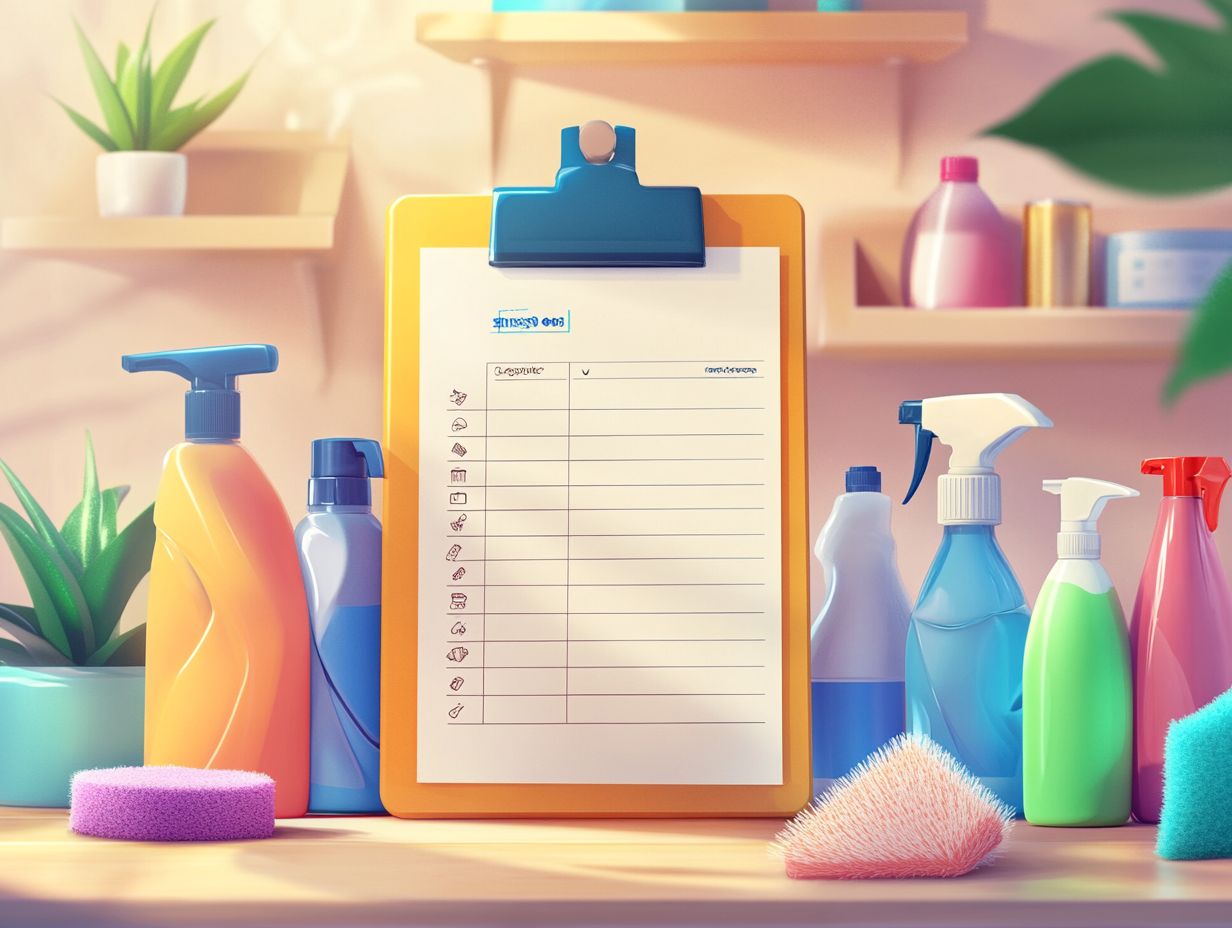
Effective communication with your cleaning staff is crucial for maintaining an accurate inventory of cleaning supplies. It enables you to make timely requests and updates when supplies run low. Using cleaning supply checklists and inventory management tools can support this process.
When your team members feel empowered to provide feedback on inventory levels and supplier reliability, your organization can quickly adapt to changing demands. This ensures that essential items are always readily available. Regular discussions about the cleaning supply checklist not only boost awareness of current stock but also create a collaborative environment where improvement suggestions are genuinely valued. Utilizing team management and feedback systems can further enhance this collaborative process.
This ongoing dialogue can lead to exciting new insights that refine your inventory practices, optimize ordering processes, and strengthen relationships with suppliers. Ultimately, this proactive approach leads to fewer disruptions and a more efficient cleaning operation. Leveraging supplier information and usage rates can also contribute to this efficiency.
Frequently Asked Questions
What is a cleaning supply inventory?
A cleaning supply inventory is a detailed list of all the cleaning products, tools, and equipment that are available in a particular space or location. It helps to keep track of what cleaning supplies are on hand, what needs to be restocked, and when they were last used. Using digital tools and cloud-based software can simplify this process.
Why is it important to create a cleaning supply inventory?
Creating a cleaning supply inventory is important for several reasons:
- It ensures that you have all the necessary supplies to keep your space clean and organized.
- Helps to avoid waste and overstocking.
- Allows for easy tracking and restocking of supplies.
Utilizing inventory management systems can help you achieve these goals.
How do I start creating a cleaning supply inventory?
The first step is to gather all the cleaning supplies in a specific area and categorize them based on their purpose. For example, you can have categories like:
- Disinfectants
- Window cleaners
- Floor cleaners
Next, create a spreadsheet or list to document each item and its quantity. Tools like Excel and Google Sheets are very useful for this purpose.
How often should I update my cleaning supply inventory?
You should update your cleaning supply inventory at least once a month. If you notice that certain supplies are running low or out of stock, update it right away to keep your cleaning routine running smoothly!
Tracking your supplies as they run low can help you stay updated.
What information should I include in my cleaning supply inventory?
Your cleaning supply inventory should include:
- The name of the product
- Brand
- Quantity
- Expiration dates (if applicable)
You can also add notes for specific products, such as where they are stored or how often they are used. Including supplier information can enhance the accuracy of your inventory.
Can I use a digital tool to create a cleaning supply inventory?
Yes! There are several digital tools and apps available that can help you create and manage your cleaning supply inventory. These tools offer features such as:
- Barcode scanning
- Automatic restocking reminders
These features make the inventory process more efficient and streamlined. Check out user-friendly apps like Coefficient.io or Janitorial Manager to streamline your inventory management!
Gather your supplies now and start your inventory today for a more organized cleaning experience!
